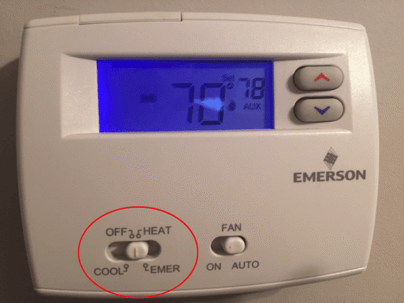So, your heat pump switches to “AUX heat” when it’s in heating mode—and you’re wondering if it’s normal.
What is Auxiliary Heat?
First off, AUX heat refers to your heat pump’s auxiliary (backup) heat source. Auxiliary heat kicks on when your heat pump can’t produce enough heat to warm your home by itself.
AUX heat mode is normal when:
- The temperature outside is below freezing
- Your thermostat is calling for a high-temperature increase (2–4°F)
- The heat pump is in defrost mode
Before we get more into when your heat pump should run in AUX heat mode, let’s go over how a heat pump heats your home.
Is your heat pump in auxiliary mode when none of the 3 situations above apply? That usually indicates a malfunction, which likely means your heat pump needs repair.
Call us at 512-580-8837 or schedule an appointment online. We’ll send a tech right over!
How Heat Pumps Work
To heat your home, a heat pump works like an air conditioner in reverse: it extracts heat from the air outside and sends it into your house. Because heat pumps only transfer heat (not generate it like a furnace), they’re a highly efficient form of heating.
We cover heat pump operation in more detail in our blog, “Heat Pump vs Conventional Air Conditioner in San Marcos, TX”.
What is the Difference Between Auxiliary Heating and Normal Heat Pump Heating?
The answer depends on what kind of auxiliary heating your system uses.
Most San Marcos homes have 1 of 2 types of auxiliary heating:
- Electric resistance heating, which uses heat strips (standard with every heat pump) installed in your ductwork. This type of heating is highly inefficient.
- Gas furnace. Called a “dual-fuel system”, the gas furnace kicks on when the heat pump can no longer efficiently pull heat from the cold air outside. Dual-fuel systems are much more efficient and keep you more comfortable than electric resistance heating.
Note that auxiliary heating is not the same thing as emergency heating (displayed as “EM HEAT” or “EMER” on most thermostats). While auxiliary heating indicates that your heat pump automatically switched from normal to auxiliary heating, emergency heating is a setting that allows you to manually set your system to auxiliary heating.
You should only use your heat pump’s emergency heating mode when it’s truly an emergency (e.g., your heat pump isn’t working in winter) because manually overriding your system means it won’t run as efficiently as it can—which will result in higher energy bills.
When is Auxiliary Heat Needed?
When the temperature outside is below freezing
Heat pumps have one drawback: They lose efficiency as the temperature drops. Heat pumps are highly efficient to about 32°F. Below freezing, your heat pump simply can’t draw enough heat from the cold air outside and will kick on its auxiliary heat mode to generate heat for your home.
So, before you call a professional to diagnose a problem, check the outdoor temperature. If it’s an unusually cold day in San Marcos, don’t be surprised to see “AUX heat” on the thermostat.
You need a high increase in temperature
Your AUX heat will kick in depending on the temperature differential between what you’ve set on the thermostat and the actual indoor temperature. Usually, this differential is more than 2-4°F, but it depends on your heat pump model.
Try not to increase your thermostat by more than 2-4°F than your current indoor temperature. The AUX heat boosts your system to generate more heat to warm your home quicker than the heat pump typically would. Once the indoor temperature reaches your set temperature, the AUX heat shuts off.
The heat pump is in defrost mode
Although we don’t get a lot of sub-freezing temperatures in San Marcos, your heat pump could enter what’s called “defrost mode”, which prevents your outdoor unit from freezing over. In defrost mode, your system will essentially run in cooling mode for a few minutes to allow the coils in the outdoor unit to warm up.
You’ll know your system is in defrost mode if the outdoor fan has stopped circulating and you see puffs of steam coming from the unit. Some models even have a blinking light on the outdoor unit that indicates your unit is in defrost mode.
During defrost mode, your system will use auxiliary heating to heat your home in the meantime. The heat pump should kick back to normal heating mode after a few minutes.
Contact Product Air Heating & Cooling, LLC Today
At Product Air Heating & Cooling, LLC, we understand the importance of reliable and efficient heating solutions for your home in San Marcos. If you're experiencing issues with your heat pump and it switches to "AUX heat," it's important to determine if it's functioning properly. If none of the situations mentioned above apply, it may indicate a malfunction that requires repair. Our team of experts is ready to help.
When you choose us, you benefit from our reliable relationships, as many of our employees have been with us for 10+ years. This means you'll always hear a familiar voice on the phone or see a familiar face at your door, providing a personalized and trustworthy experience.
We also prioritize reliable scheduling, offering same-day service and 2-hour scheduling windows. We understand that your time is valuable, so we strive to provide service at a time that's convenient for you, ensuring minimal disruption to your day.
What sets us apart is our commitment to reliable people. We invest in continuous training for our employees, ensuring they are up to date with the latest industry knowledge and techniques. You can have confidence that your job will be done right the first time, providing you with peace of mind and efficient heating for your home.
Is your heat pump struggling to keep up? Give us a call at 512-580-8837 or schedule an appointment online. Learn more about what to expect when you hire us on our heat pump repair page!

